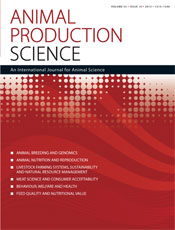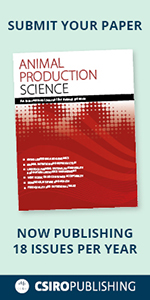
Animal Production Science
Volume 55 Number 10 2015
AN15123Mineral nutrition of sheep: new insights into interactions when grazing vegetative crops
AN14658Liveweight gains of young sheep grazing dual-purpose wheat with sodium and magnesium supplied as direct supplement, or with magnesium supplied as fertiliser
Sheep grazing wheat may consume a diet deficient in magnesium or sodium. We measured liveweight gain of sheep to these elements, provided separately or together, while they grazed dual-purpose wheat. Direct supplements in feed troughs led to profitable 20–25% increases in liveweight gain, but fertilising the wheat with Mg was ineffective and unprofitable. Thus, direct supplementation is recommended in farming practice.
AN15020Comparison of the alkane-based herbage intakes and the liveweight gains of young sheep grazing forage oats, dual-purpose wheat or phalaris-based pasture
Grazing of dual-purpose crops can provide extra winter feed, but there are few data about herbage intakes or liveweight gains of livestock grazing crops. We measured these in sheep grazing pasture cf. wheat or oat forage and found greater herbage intakes and liveweight gain in sheep grazing crop. Dual-purpose crops can thus increase winter feed supply and quality and improve animal weight gains in a grazing system.
AN14440The influence of season on lambs' feeding preference for plantain, chicory and red clover
Mixed species swards can provide good quality herbage for sheep over summer and autumn. The studies reported here examined grazing preference and diet selection of lambs for plantain, chicory, red clover and ryegrass. Some seasonal differences were noted for chicory and plantain, but they were never significantly lower than that of ryegrass and were likely due to seasonal changes in nutritive value. Pastures with a diverse range of plant species offer a unique opportunity to maximise animal feed intake and perhaps the nutritive value of that selected.
AN14050Influence of maize particle size on the kinetics of starch digestion in the small intestine of growing pigs
The digestion rate of starch in the small intestine of pigs can affect the efficiency of nutrient utilisation. This study aimed to evaluate the digestion kinetics of starch, nutrient utilisation and performance of growing pigs fed diets containing corn of different sizes. The smaller corn particle had higher rate of digestion and feed efficiency without impacting the digestibility of starch. This may influence the amino acid requirement of pigs and should be considered in the formulation of diets.
AN14657A combination of xylanase, amylase and protease influences growth performance, nutrient utilisation, starch and protein digestive dynamics in broiler chickens offered maize-, sorghum- and wheat-based diets
The inclusion of exogenous enzymes in poultry diets has increased remarkably in recent decades; however, there is a lack of parallel comparison of enzyme responses in broiler diets based on different grains. A combination of xylanase, protease and amylase was shown to significantly improve energy utilisation in maize-, sorghum- and wheat-based diets, and with more pronounced improvement of feed conversion efficiency in maize-based diets. The differences of enzyme response in nutrient digestion should be considered when diets based on various grains are formulated.
AN14137Biological defleecing: intravenous infusion of amino acid mixtures lacking lysine and methionine creates a weakened zone in the wool staple, which is amenable to mechanical wool harvesting
An alternative to manual shearing of sheep is required if the wool industry is to remain competitive with other textile fibres in the marketplace. We demonstrate that it is possible to create a weak zone in wool that can then remain on the animal for several weeks before removal without shearing. This work demonstrates the feasibility of a new approach to wool removal that should be further investigated.
AN14032GNSS technology and its application for improved reproductive management in extensive sheep systems
GNSS tracking offers scientists a research tool to study livestock behaviour under pastoral conditions. As the reproductive efficiency of Merino sheep in Australia is poor, the application of GNSS technology offers a potential means to improve reproductive efficiency through enhanced behaviour monitoring. This study found Merino ewes displayed a change in their daily activity pattern during oestrus. Thus, remote detection of oestrus through monitoring of changes in normal ewe behaviour may be possible through the application of GNSS technology.
AN13453Changes in behaviour, milk production and bodyweight in beef cows subjected to two-step or abrupt weaning
Artificial weaning is one of the greater stressors for farm animals. Therefore, we tested if the use of nose flaps on calves to end suckling improves the cows’ welfare after definitive weaning. As this management decreased the main behavioural changes that indicate distress and decreased the bodyweight loss of the cows after the definitive separation it may be recommended for practical application.
AN14093Heart rate variability: a biomarker of dairy calf welfare
Quantifying chronic stress, from pain and suffering, to assess welfare in farmed animals can be elusive, because behavioural observations are highly subjective and emotions of fear are hidden, while levels of the stress hormone (cortisol) are typically normal. Dairy calf welfare is compromised; from stress of early weaning, separation and isolation. We measured these management stressors non-invasively using heart rate variability (HRV) and showed that HRV was a welfare biomarker.
AN13505Growth performance, and carcass and meat quality traits in progeny of Poll Nellore, Angus and Brahman sires under tropical conditions
The Zebu breeds produce meat with organoleptic characteristics that are not well accepted in most demanding markets. This study aimed to characterise progeny of sires representing several major families in the Poll Nellore breed in Brazil. There is substantial variation within the Poll Nellore breed for carcass and meat traits, and several sires have a proportion of their progeny comparable in terms of meat tenderness to those of Angus sires.
AN14147Performance of beef Guzerat and Guzerat-cross bulls during the feedlot, and carcass traits of Guzerat-cross groups
Guzerat (Bos indicus breed) animals have been used in crossbreeding programs for either beef, dairy or dual purposes, but studies evaluating their performance and carcass traits are scarce. We evaluated performance, carcass traits and meat cuts of Guzerat-based bulls. Results from this study indicate that all groups evaluated have potential for meat production since they meet the Brazilian beef industry standards, and bulls from a dual-purpose cross can be an option for dairy producers, to diversify revenues.
AN13378Biochemical profiles and physicochemical parameters of beef from cattle raised under contrasting feeding systems and pre-slaughter management
Animal diet and pre mortem handling may affect the biochemical conversion of muscle into meat. The aim of the present study was to evaluate the effect of two different pre-slaughter handling in Angus steers raised and finished in two contrasting feeding systems on the muscle metabolism and the related meat quality. The results obtained showed an impact of pre-slaughter handling and feeding systems on the peri mortem biochemistry and in the related meat quality through pH-independent mechanisms.
AN14684Effects of supplementary bee pollen and its polysaccharides on nutrient digestibility and serum biochemical parameters in Holstein calves
The present study evaluated bee pollen or its polysaccharides as a feed additive in calves. The growth performance, serum biochemical parameters and nutrients apparent digestibility of 14–70-day-old calves were investigated and these showed that dietary supplementation of bee pollen and its polysaccharides at an optimum dosage were of benefit to calves. Bee pollen should be a new additive in a calf’s diet.
AN14516Effect of hypothyroidism on growth performance, carcass composition and meat quality of fat-tailed Lori-Bakhtiari lambs
Lamb meat quality is increasingly important to international markets and to consumers and is affected by a variety factors including the level of thyroid hormones. We evaluated the effects of hypothyroidism on growth performance and meat quality of growing lambs. Our results indicate that mild hypothyroidism may have some beneficial effects on growth efficiency and meat quality of lambs.
AN13556Processing and storage of ratite oils affects primary oxidation status and radical scavenging ability
Treatments for cardiovascular and gastrointestinal diseases seek to minimise oxidative damage by free radicals through the use of antioxidants such as those found in ratite (flightless birds) oils. The current study identified several factors which may impact the clinical efficacy of Emu Oil including farm location, diet composition, rendering procedures, time of render and duration of storage. Further studies would facilitate standardisation of Emu Oil bioactivity to ensure consistent health benefits.
AN14526Integrated animal and cropping systems in single and multi-objective frameworks for enhancing the livelihood security of farmers and agricultural sustainability in Northern India
Reduced productivity and environmental concerns caused by intensive cultivation of rice-wheat systems necessitate diversification of farming in Northern India. Therefore s study was undertaken to develop models of integrated farming systems (IFS), involving animals and cropping, for various sizes of farm and to compare them with rice-wheat. The study revealed that IFS offer more perspectives for an economically viable and sustainable agriculture for typical farms in the region.



